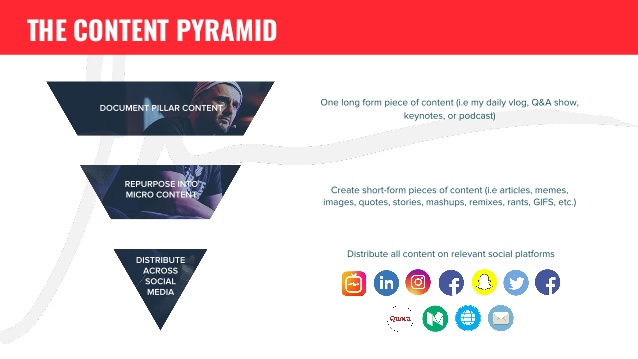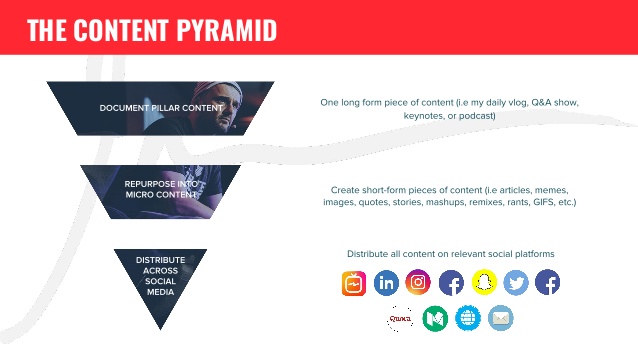30-second summary:
- A marketing strategy that focuses on a unique target market is called a niche-hub strategy. Create a niche website and document its progress.
- Use content formats that boost audience engagement and are easy to produce, such as blog posts, videos, lists, webinars, etc.
- People engage more with a site that loads fast. Therefore, improve site speed by using affordable options such as cloud storage and AMP.
- User-generated content makes your brand more personable. Engage with your audience by embedding their comments into your article, running contests, giveaways, or using a hashtag.
- Country of origin affects consumer behavior. Consider a country-specific blog content strategy to acquire traffic from specific countries.
- Make use of reverse content Pyramid strategy. Create one piece of “pillar content” and repurpose it into other pieces of content. Finally, distribute them on relevant social media platforms.
- Invest in dynamic Facebook ads and use the IGTV feature of Instagram to engage with your audience and convert them into consumers.
One of the best ways for ecommerce businesses to enhance their business presence is via content marketing. Around 92% of businesses consider content as their business asset. It’s no wonder that content marketing can offer up to three times more ROI as compared to paid search. However, a majority of ecommerce companies fail at content marketing. Here are the top seven ways to upgrade your ecommerce content marketing strategy:
1. Use the most popular content formats
The easiest way to identify the success of ecommerce content marketing is by measuring user engagement.
Every human thinks differently. Hence, you should create different content formats for the various needs of the users.
The below content formats have been proven to be most successful in enhancing user engagement:
- Blog posts: Companies that blog regularly produce 67% more leads. Create relevant, engaging, and comprehensive blog posts by targeting long-tail keywords that match the exact intent of the user.
- Videos: 82% of all internet traffic will be videos by 2022. Hence, text-based blogging will slowly be replaced by text+video blogging. Create videos for every blog post and prepare transcripts for every video.
- Research articles: Content related to original research that offers new and actionable insights for the audiences are the most linked. Conduct research by taking surveys or running tests and share the results with your audience.
- Images and infographics: People rarely share blog content without images. The scope of engagement is also limited. Hence, you should always create high-quality and customized images for your blog. Content with images receives 97% more views. Similarly, infographics are a great content choice because they cover heavy topics in an easy to understand way. People share them on social media leading to high engagement.
- Webinars: The average registration number of a webinar is around 260. You can run webinars by inviting popular influencers in your niche to increase the flow of registrations. Webinars are educational, and they help to convert viewers into customers.
- Lists: People love lists. Create listicles like top 10 or best ways and share them on social media. Listicles are psychologically seductive because it condenses the information into several points.
To have an idea about the best content format for your website, you can take the help of Google Analytics. Here is a guide to add GA on your WordPress blog. Once installed, you can start tracking the traffic, bounce rate, and time on the top pages of your site. The information provided by Google Analytics can be used to identify and optimize the content on your site.
2. Adopt the niche-hub blog strategy
The niche-hub strategy focuses on making your ecommerce blog a resource for a niche topic.
The first step is adding a blog to your online store. WordPress is the best platform to start your blog because it offers different plugins to manage all your tasks.
Next step is choosing a web host to store all your blogging files. It is crucial to choose a web host that offers a strong uptime. Providers like GoDaddy are considered highly reliable, with more than 99% uptime.
For instance, if you are selling mugs online, then your blog can become a resource containing articles, videos, whitepapers, podcasts related to mugs.
For example, HubSpot is a niche for anything related to marketing, sales, support, and website. They create content that is relevant to the audiences of HubSpot.
Leveraging this strategy, they can acquire millions of traffic to their site. You can create a niche blog and start nurturing traffic to gain more customers.
3. Improve site speed for better UX
Site speed is a crucial ranking factor. If you are looking for a hack to raise the organic rankings of your content, then take steps to improve your site speed.
Google Page Experience will be launched in May 2021. The update focuses on improving UX and site speed is an important factor under Page Experience.
The best way to improve site speed is to use a CDN. However, for small business owners, it becomes difficult to host content on a CDN because they are costly.
If you do not have great website traffic flow, your cost of CDN won’t be justified.
In such a case, emulating the working of a CDN with cloud storage can be an affordable option.
All you need to do is to choose a cloud storage provider like Sync, Google Drive or P Drive and make all your files available for direct public access (leaving the confidential ones that are blocked by robots.txt).
Another great way to increase page speed is to create AMP versions of your content. AMP stands for Accelerated Mobile Pages. Here is a great guide to creating your first AMP page.
4. Involve your audience to create UGC (user-generated content)
UGC (user-generated content) is one of the best ways to generate buzz for your ecommerce brand.
85% of people are influenced by user-generated content (UGC) as compared to brand content.
You can start a photo or video contest on social media and ask audiences to share their best pic with your product.
You can get audiences to interact with your brand via branded hashtags, and the added visibility will help you to capture more audiences.
For instance, the Sudbury Wolves hockey team ran a contest on Instagram to persuade people to share a caption for a photo to win two tickets for the opening match of the Ontario Hockey League. This is a great way to enhance brand visibility and consumer engagement.
Similarly, Adobe ran a campaign called the ArtMaker Series where they invited designers and artists to share their artwork created using any of the Adobe products. They used the UG content for product promotions and expert endorsements.
You can use UG content to upgrade your ecommerce content strategy. You only need to think of some innovative ideas and apply them to your main strategy.
5. Create country-specific blog content
Cross-border B2C ecommerce is expected to reach $4820 billion by 2026.
If you are an international seller, you should consider adopting a country-specific blog content strategy.
Country of origin affects consumer behavior. Here are some of the ways to make this happen:
- Share content that is locally relevant to your audience.
- Create articles written by local authors.
- Promote local products produced by local manufacturers.
- Target local events and reap in local influencers to market your content.
For example, Shopify creates country-specific blog content to target customers. Here is an example content piece that was written to target consumers during the IPL season in India, which is considered to be a big event. The content was targeted for sellers and helped them gain insights on how they can increase their sales on their Shopify store during the IPL season.
6. Leverage the reverse content pyramid strategy
The Reverse content pyramid strategy is suggested by Gary Vaynerchuk. This strategy is useful to repurpose content to different channels.

You create a pillar content and distribute it on several channels by revising it according to the theme of the platform. For example, you can create video content and convert it into other content formats like an article or a podcast.
Besides, you should create lots of ‘micro-content’ to drive traffic to your pillar content piece. These micro-content pieces should be shared on social media platforms such as Instagram, Pinterest, Facebook, Twitter, LinkedIn, and other channels where your target audiences are present.
For example, if you are a pet store owner, then you can create a long-form pillar content piece related to ‘small dog breeds’. After that, you can create several micro-content pieces on every dog breed mentioned in your pillar article. Micro-content can take the form of memes, quotes, or stories. All these micro-content pieces should link to your pillar content.
Now, you should share all these micro-content pieces on your social channels. Get insights from the community and create community-driven micro-content that your audiences would love to see. Redistribute the second round of micro-content. The reverse content pyramid model is a great way to strengthen the popularity of your pillar content, which would help it to rank for several related search queries to reach customers during their buyer journey.
7. Elevate social engagement and reach
Ecommerce businesses present on social media platforms have, on average, 32% more sales than businesses without one.
The key to social media is visual content such as infographics, images, and videos. For ecommerce businesses, social media is not just a destination for posting content but a powerful means of converting followers into consumers.
As per Sprout Social, 89% of marketers use Facebook in their brand marketing efforts. And, more than 80% of people say Instagram helps them discover, research, and decide to purchase new products and services.
Use the following latest Facebook and Instagram marketing strategies to elevate engagement and reach.
- Invest in Facebook Dynamic Ads: Dynamic ads allow merchants to reignite interest in consumers who visited your website, checked items, or added items to their cart. It utilizes the information provided through the tracking pixel to show those visitors the exact items they checked to pull them back in and earn a conversion.
- Use Sales options on the Facebook Business page: Create a “Shop” button on your Facebook business page to list several products that allow consumers to purchase merchandise directly from Facebook.
- Start Using Shoppable Posts on Instagram: Shoppable Instagram posts allow you to showcase your storefront within the social network. You can tag the products shown in your images.
- Use IGTV feature: IGTV gives you the ability to share videos that are up to an hour-long. It also notifies your followers when you share a new video. IGTV allows viewers to tap items they see in videos and complete their purchase through Instagram’s direct checkout feature or the seller’s website.
Conclusion
Ecommerce businesses should use content marketing to their advantage because it is one of the most ROI-friendly channels to attract relevant customers. Follow the strategies discussed in this article to upgrade your content strategy and grow your brand awareness, traffic, and eventually, profits.
The post Seven smart ways to upgrade your ecommerce content marketing strategy appeared first on Search Engine Watch.
